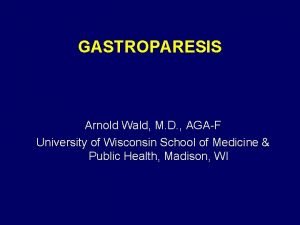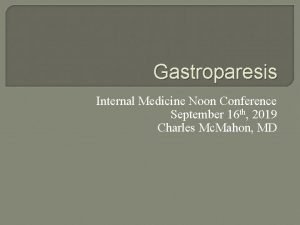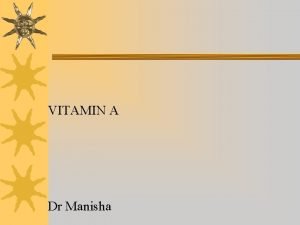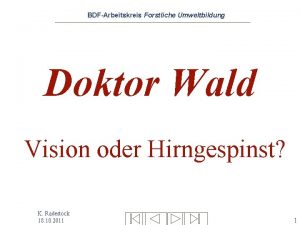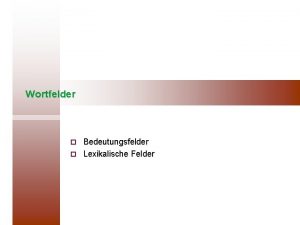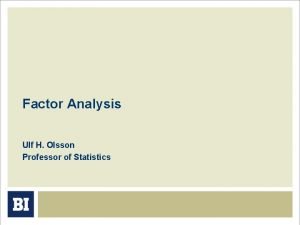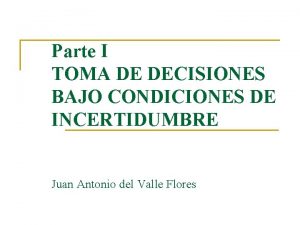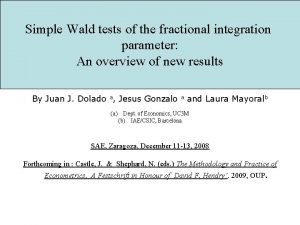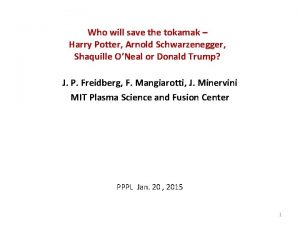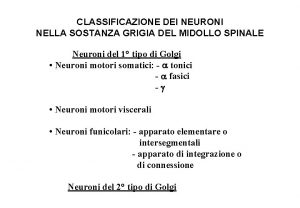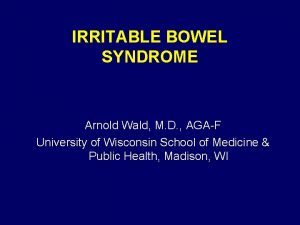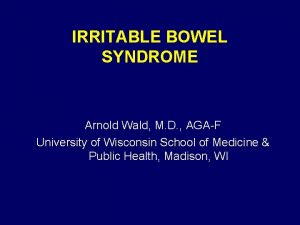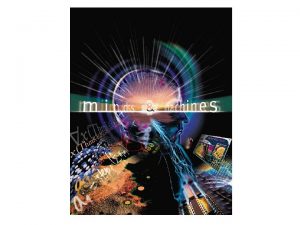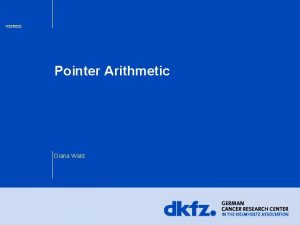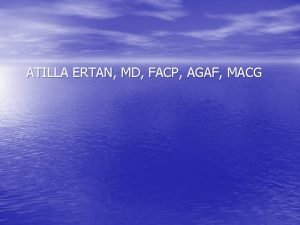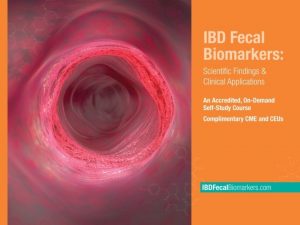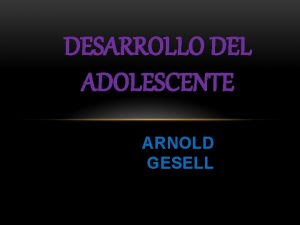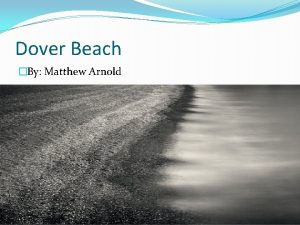GASTROPARESIS Arnold Wald M D AGAF University of

























- Slides: 25

GASTROPARESIS Arnold Wald, M. D. , AGA-F University of Wisconsin School of Medicine & Public Health, Madison, WI

MAIN FUNCTIONS OF STOMACH I. PROXIMAL Functions: Accommodation Storage of ingested food Regulation of intragastric pressure Tonic movement of chyme Motor Pattern: Tonic activity II. DISTAL Functions: Grinding of food Emptying to duodenum Motor Pattern: Phasic activity

Motility of the Antral Pump Is Initiated by a Dominant Pacemaker in the Mid-corpus Pacemaker potentials determine contractile parameters Contractile parameters · Max frequency (3/min) · Propagation velocity · Propagation direction Fundus Pacemaker region Pacemaker potential Pylorus Antrum Corpus The antral pump is formed by the mid and distal corpus, antrum, and pylorus B 87 B 3

Onset and Rate of Gastric Emptying Varies With the Composition of the Meal Emptying phase Lag phase 100 Solid meal 75 % Meal 50 remaining in stomach Semisolid meal 25 Liquid meal 0 0 20 40 60 Time after meal (min) 80 100 B 4

Gastric emptying – evolving concepts • Relationship with symptoms unclear – NOT nausea, vomiting or pain – Accelerating gastric emptying does not necessarily improve symptoms – Symptomatic improvement including weight gain is possible without improving gastric emptying Gastroparesis is frequently overdiagnosed on the basis of outdated emptying tests

Causes of Gastroparesis • Idiopathic 36% • Diabetic 29% • Upper GI surgery 13% • Parkinson’s 8% • Collagen tissue disorder 5% • Intestinal pseudo-obstruction 4% • Miscellaneous (Incl eating disorders) 6% Soykan et al, DDS 1998; 43: 2398 -2404

Drugs that delay gastric emptying (Partial listing) β Agonists Anticholinergics Tricyclic agents Phenothiazines Dopamine agonists Opiates Proton pump inhibitors Miscellaneous Dexfenfluramine Lithium Tetrahydrocannabinol Tobacco Antihistamines

Workup for suspected gastroparesis UGI Series: Excludes mechanical obstruction Retention of barium w/o obstruction is diagnostic Endoscopy: Bezoar without obstruction highly suggestive Gastric Emptying: Solids more sensitive than liquids

Normal values for low fat, egg white GES Time 0. 5 hr. 1. 0 hr. 2. 0 hr. 4. 0 hr. * ** Lower normal limit Upper normal limit for gastric retention** 70% 30% 90% 60% 10% Lower value suggests rapid emptying Higher values suggest delayed emptying Am J Gastroenterol 2008

2. A 30 y. o. woman with a one year history of type II diabetes mellitus presents with nausea and early satiety. Her blood sugars have been erratic and her last HBAIC was 9. 2. Endoscopy was normal and a gastric emptying test showed 20% retention of the meal at 4 hours (normal < 10%). Which of the following would you recommend: • a) Metoclopramide • b) Rigorous control of blood sugars • c) Erythromycin • d) Botulinum toxin injection of the pylorus

Slow gastric emptying was frequent in women with type 2 diabetes with hyperglycemia and normalized after diabetic control J Diabetes & Complications, 2013

2. A 23 y. o. woman developed a viral illness associated with fever, myalgias, nausea, vomiting and diarrhea. Although most of her symptoms resolved over 2 weeks, she continued to have nausea, occasional retentive vomiting, early satiety and a 10 lb. weight loss. Endoscopy showed a modest amount of retained food in the stomach and a gastric retention of a test meal consisting of egg whites, toast and jam at 4 hours was 35% (normal <10%). Which of the following would you recommend first? a) Metoclopramide b) Botulinum toxin injection (pylorus) c) Erythromycin d) Gastric stimulator

Management of Gastroparesis Dietary Modifications Small frequent (6/day) meals Reduced fat (<40 gm/day) Soup, crackers, noodles, pasta, potatoes, rice, cheese Reduced fiber helps avoid bezoar Liquid caloric supplementation

Prokinetic Agents • ACh-esterase inhibitors: pyridostigmine • Motilides: erythromycin • Antidopamine agents: domperidone* • Antidopamine/serotonin agents: • metoclopramide • Serotonin agents: tegaserod*, prucalopride* *Not available in USA

ERYTHROMYCIN • Motilin agonist • No antiemetic effect • Stimulates antral contractions (IV >> PO) • Stimulates MMC • Dose: 125 -250 mg bid/tid (PO) 3 mg/kg q 8 hours (IV)

Metoclopramide • Central/peripheral D 2 antagonist and 5 HT agonist • Increases antral contractions • Decreases fundal relaxation • Improves antroduodenal coordination • Dose: 5 -20 mg qid (PO, IV, SQ, SL)

Metoclopramide • 30% of patients experience side effects • 10% have neurologic side effects Parkinson-type syndrome Tardive dyskinesia • Hyperprolactinemia * Boxed Warning for chronic use issued by FDA*

Domperidone • • Peripheral D 2 antagonist Increases antral contractions Decreases fundal relaxation Improves antroduodenal coordination • Dose: 10 -30 mg qid (PO) Limited availability in USA

Efficacy of Domperidone in Diabetic Gastroparesis □ Improved symptoms in 64% □ Improved gastric emptying in 60% □ Reduced hospital admission in 67% □ 28 trials (19 double arm); 1016 patients Sugumar A et al, CGH 2008

Effects of Botulinum Toxin on GE and GI Symptoms Within Group Botox P Placebo Between Group P P Improved % 37. 5 56. 3 0. 29 GCSI score -6. 8 + 9. 2 0. 01 -10. 1 + 12. 7 0. 01 0. 42 GVAS score -190 + 228 0. 01 -176 + 256 0. 02 0. 88 % Gastric retention 2 hr -16. 3 + 22. 9 0. 02 -10. 8 + 20. 6 0. 08 0. 52 % Gastric retention 4 hr -13. 3 + 18. 0 0. 01 -3. 6 + 25. 5 0. 62 0. 27 Friedenberg FK, et al. Am J Gastro 2008

3. A 28 y. o. man with IDDM is referred for chronic and recurrent nausea and vomiting. He reports 3 -4 episodes yearly for the past 5 years with frequent ED visits or hospitalizations lasting 3 -4 days. Between episodes, he feels well and has lost no weight. During these episodes, he finds great relief when taking hot showers. The most appropriate intervention for this patient is: • a) Domperidone 20 mg AC meals • b) Nortriptyline in doses up to 100 mg hs • c) Discontinue smoking marijuana • d) Strict control of blood sugars; metoclopramide 10 mg SQ during episodes

Cyclic Vomiting Syndrome Recurrent and stereotypical episodes of severe nausea and vomiting separated by symptom free intervals - Gastric emptying rapid or normal - Maintenance of weight

Cannabinoid Hyperemesis - Cyclic vomiting syndrome - Compulsive hot water bathing - Poor response to TCAs

Cyclic Vomiting in Adults (Non-Cannabinoid) • Association with migraine headaches • Psychological disorders (anxiety/depression) • Absence of compulsive hot water bathing • Often responds to TCAs

References 1. Hasler WL. Gastroparesis: pathogenesis, diagnosis and management. Nat Rev Gastroenterol Hepatol 2011; 8: 438 -53. 2. Choung RS et al. Cyclic vomiting syndrome and functional vomiting in adults. Neurogastroenterol Motil 2011; 24: 20 -26
 Arnold wald md
Arnold wald md Edy soffer
Edy soffer Gastroparesis cardinal symptom index calculator
Gastroparesis cardinal symptom index calculator Walds visual cycle
Walds visual cycle Gedicht doktor wald
Gedicht doktor wald Survivorship bias
Survivorship bias Ich ging im walde so für mich hin text
Ich ging im walde so für mich hin text Wortfeld bedeckt
Wortfeld bedeckt Svet b
Svet b Analisi di regressione logistica
Analisi di regressione logistica Wald test example
Wald test example Die kirche der natur
Die kirche der natur Wald test
Wald test Wald
Wald Ingo wald
Ingo wald Matriz de arrepentimiento
Matriz de arrepentimiento Simple wald
Simple wald Wald mathematician
Wald mathematician Matthew arnold culture definition
Matthew arnold culture definition Arnold building fred hutch
Arnold building fred hutch Harry potter arnold
Harry potter arnold Arnold owiti
Arnold owiti Jw arnold elementary school
Jw arnold elementary school Arnold air society motto
Arnold air society motto Midollo spinale
Midollo spinale Isolation to marguerite
Isolation to marguerite
